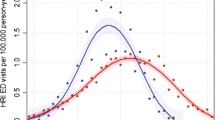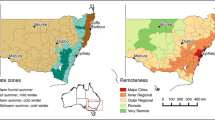Abstract
Extreme heat events are responsible for more deaths in the United States than floods, hurricanes and tornados combined. Yet, highly publicized events, such as the 2003 heat wave in Europe which caused in excess of 35,000 deaths, and the Chicago heat wave of 1995 that produced over 500 deaths, draw attention away from the countless thousands who, each year, fall victim to nonfatal health emergencies and illnesses directly attributed to heat. The health impact of heat waves and excessive heat are well known. Cities worldwide are seeking to better understand heat-related illnesses with respect to the specifics of climate, social demographics and spatial distributions. This information can support better preparation for heat-related emergency situations with regards to planning for response capacity and placement of emergency resources and personnel. This study deals specifically with the relationship between climate and heat-related dispatches (HRD, emergency 911 calls) in Chicago, Illinois, between 2003 and 2006. It is part of a larger, more in-depth, study that includes urban morphology and social factors that impact heat-related emergency dispatch calls in Chicago. The highest occurrences of HRD are located in the central business district, but are generally scattered across the city. Though temperature can be a very good predictor of high HRD, heat index is a better indicator. We determined temperature and heat index thresholds for high HRD. We were also able to identify a lag in HRD as well as other situations that triggered higher (or lower) HRD than would typically be generated for the temperature and humidity levels, such as early afternoon rainfall and special events.






Similar content being viewed by others
References
Bassil, K. L., D. C. Cole, R. Moineddin, A. M. Craig, W. Y. W. Lou, B. Schwartz, and E. Rea. 2009. Temporal and spatial variation of heat-related illness using 911 medical dispatch data. Environmental Research 109 (5):600-606.
Census, U.S. (2009) Quick Facts: Chicago. Available at http://egov.cityofchicago.org/webportal/COCWebPortal/COC_EDITORIAL/Demographics0607.pdf
Conti S, Meli P, Minelli G, Solimini R, Toccaceli V, Vichi M, Beltrano C, Perini L (2005) Epidemiologic study of mortality during the Summer 2003 heat wave in Italy. Environ Res 98:390–399
Diaz J, Jordan A, Garcia R, Lopez C, Alberdi JC, Hernandez E, Otero A (2002) Heat waves in Madrid 1986–1997: effects on the health of the elderly. Int Arch Occup Environ Health 75:163–170
Dolney TJ, Sheridan SC (2006) The relationship between extreme heat and ambulance response calls for the city of Toronto, Ontario, Canada. Environ Res 101:94–103
Environmental Protection Agency (2008) The heat island effect. Chicago. Available at: http://www.epa.gov/hiri/pilot/chicago.html. Accessed: 4 May 2008
Fouillet A, Rey G, Laurent F, Pavillon G, Bellec S, Guihenneuc-Jouyaux C, Clavel J, Jougla E, Hemon D (2006) Excess mortality related to the August 2003 heat wave in France. Int Arch Occup Environ Health 80:16–24
Golden JS, Hartz D, Brazel A, Luber G, Phelan P (2008) A biometeorology study of climate and heat-related morbidity in Phoenix from 2001 to 2006. Int J Biometeorol 52:471–480
Gosling S, Lowe J, McGregor G, Pelling M, Malamud B (2009) Associations between elevated atmospheric temperature and human mortality: a critical review of the literature. Clim Change 92:299–341
Hajat S, Armstrong B, Baccini M, Biggeri A, Bisanti L, Russo A, Paldy A, Menne B, Kosatsky T (2006) Impact of high temperatures on mortality: is there an added heat wave effect? Epidemiology 17:632–638
Hutter HP, Moshammer H, Wallner P, Leitner B, Kundi M (2007) Heatwaves in Vienna: effects on mortality. Wien Klin Wochenschr 119:223–227
Jones TS, Liang AP, Rilbourne EM, Griffin MR, Patriarca PA, Wassilak SGG, Mullan RJ, Herrick RF, Donnel HD Jr, Choi K, Thacker SB (1982) Morbidity and mortality associated with the July 1980 heat wave in St. Louis and Kansas City, MO. J Am Med Assoc 247:3327–3330
Kalkstein LS, Smoyer KE (1993) Human biometeorology - the impact of climate-change on human health - some international implications. Experientia 49:969–979
Klinenberg E (2002) Heat wave: a social autopsy of disaster in Chicago. University of Chicago Press, Chicago
Knowlton K, Rotkin-Ellman M, King G, Margolis HG, Smith D, Solomon G, Trent R, Paul E (2009) The 2006 California heat wave: impacts on hospitalizations and emergency department visits. Environ Health Perspect 117 (in press)
McGeehin MA, Mirabelli M (2001) The potential impacts of climate variability and change on temperature-related morbidity and mortality in the United States. Environ Health Perspect 109:185–189
Nakai S, Itoh T, Morimoto T (1999) Deaths from heat-stroke in Japan: 1968–1994. Int J Biometeorol 43:124–127
Nitschke M, Tucker GR, Bi P (2007) Morbidity and mortality during heatwaves in metropolitan Adelaide. Med J Aust 187:662–665
NOAA (2007) Heat wave: a major summer killer. Available at: http://www.weather.gov/om/heat/heat_wave.shtml. Accessed 2 Dec. 2008
Rothfusz LP (1990) The heat index equation: or, more than you ever wanted to know about heat index. National Oceanic and Atmospheric Administration. Available at: http://www.srh.noaa.gov/ffc/html/studies/ta_htindx.PDF. Accessed 7 April 2007
Saez M, Sunyer J, Castellsague J, Murillo C, Anto JM (1995) Relationship between Weather Temperature and Mortality: A Time Series Analysis Approach in Barcelona. Int J Epidemiol 24:576–582
Sheehan C, Noel J (2005) Power outage adds to the heat - Fire at substation leaves 51,000 in dark. Chicago Tribune (IL), 1
Tan JG, Zheng YF, Song GX, Kalkstein LS, Kalkstein AJ, Tang X (2007) Heat wave impacts on mortality in Shanghai, 1998 and 2003. Int J Biometeorol 51:193–200
United Nations Population Fund (UNFPA) (2007) State of the World Population 2007: Unleashing the Potential of Urban Growth, 108: United Nations. Available at: http://www.unfpa.org/publications/index.cfm. Accessed 18, Feb. 2009
Weisskopf MG, Anderson HA, Foldy S, Hanrahan LP, Blair K, Török TJ, Rumm PD (2002) Heat wave morbidity and mortality, Milwaukee, Wis, 1999 vs 1995: an improved response? Am J Public Health 92:830–833
Acknowledgements
This work was partially supported by the National Center for Environmental Health at the U.S. Centers for Disease Control and Prevention (Contract 30-07184-03 CDC/Task Order 0078), the City of Chicago Department of Environment, and the National Center of Excellence on SMART Innovations for Urban Climate and Energy (w ww.ASUsmart.org) at Arizona State University. We would like to thank: Dr. Elizabeth Wentz, for her help in reading the paper and her suggestions for improving the spatial components; Sainan Zhang and Kelly Mahon for their help with geocoding and GIS techniques; and the reviewers for their helpful suggestions for improving this paper.
Author information
Authors and Affiliations
Corresponding author
Rights and permissions
About this article
Cite this article
Hartz, D.A., Golden, J.S., Sister, C. et al. Climate and heat-related emergencies in Chicago, Illinois (2003–2006). Int J Biometeorol 56, 71–83 (2012). https://doi.org/10.1007/s00484-010-0398-x
Received:
Revised:
Accepted:
Published:
Issue Date:
DOI: https://doi.org/10.1007/s00484-010-0398-x




